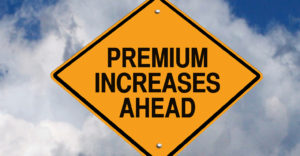If you are turning 65 or starting on a Medicare plan for the first time, there is something you should know… your Medigap premium will increase over time. It may not go up every year, but it will likely go up most years. Whatever an insurance company or insurance agent tells you to try to get you to sign up for a plan, just know that your rate WILL go up over time. This is not a pleasant topic, as no one likes to talk about paying more for insurance, but it is something that is important to understand and be aware of when you go on a Medigap plan.
There are different types of rating methodologies for Medigap plans. The vast majority of Medigap plans use attained-age ratings. This means that your rate is based on the age that you have “attained” – so obviously, under this methodology, your rate will go up each year as you get older. The normal age-based increase is anywhere from $2/mo in premium to $5/mo in premium, depending on the company and where you live.
There are other Medigap plans that use issue-age (some states require all policies to be issue-age rated) or community rating. These types of policies do not go up based on your age necessarily; however, they still have increases due to inflation and changes in Medicare’s coverage. Medigap plans expand to fill the gaps in Medicare, so if those gaps get bigger/change, Medigap plan coverage changes and so do the premiums.
What is the Average Medigap Rate Increase?
While it is very difficult to put an exact number on future Medigap rate increases, we can look at historical numbers to get an idea of what rates may do in the future. Nationally, over the last two decades, the average annual Medigap rate increase has been around 5%. There are obviously exceptions to this – some companies don’t have an increase every year, other companies have larger increases than this. But if you are doing a projection of future expenses, that would be a good round number to use.
Now, Medigap rates vary considerably depending on where you live. There are some areas of the country where Medigap rates are as much as three times higher than what rates for the same coverage are elsewhere. It is crucial to check rates based on your specific zip code and look at both current rates as well as company rating/reputation as a factor in choosing the best Medigap plan.
How Are Medigap Rate Increases Determined?
Medigap rate increases are determined by the insurance company itself. However, they must be approved by your state’s department of insurance. Also, they are applied equally to everyone. In other words, you cannot be singled out for a rate increase based on your specific health or any other factors.
We often hear clients say “I had a knee replacement/lot of doctor visits/etc (any other increased medical costs) this past year, so that’s why my rate went up”. While it may seem that way, that is never the case with Medigap policies. It does not work like a homeowner’s or auto insurance policy, where you may pay a higher amount if you have more claims because you are a higher “risk”. With Medigap policies, every one of a certain age in a certain geographic area pays the same rate, regardless of your individual health.
Aside from the age-based increases on attained-age Medigap plans, companies may also have their annual increase. These are usually based on claims ratios that the company has encountered within the last year (across all policyholders, not just you), inflation, and changes to Medicare. Companies file the requested increase to the state department of insurance, the request gets reviewed and amended or approved, then it gets passed on to policyholders.
When Do Medigap Rate Increases Occur?
Many people mistakenly think there is a Medigap “open enrollment” period each year. Open enrollment, however, is when you turn 65 or start on Medicare for the first time. After that initial open enrollment period, there is not an annual open enrollment period for Medigap (exceptions are the 5 states that have “birthday rules”). The period at the end of the year that everyone calls “open enrollment” is actually for the Part D prescription drug plans and Medicare Advantage plans.
So Medigap rate increases do not necessarily occur with the calendar year. In fact, with most companies, they do NOT occur that way. In most cases, your Medigap rate will go up on your policy anniversary date. In other words, if you turn 65 in June and start your Medicare on 6/1, then the next 6/1 (12 months later), you may get a rate increase. Likewise, your rate may go up, if it is going to go up, each 6/1. Most companies give a 12-month rate “lock” from your initial effective date, meaning that your rate will not go up for the first 12 months that you have a new policy.
Also, and this is important to note, companies are required to give a minimum of 30 day notice before any rate increase takes effect. So if you get mail from your insurance company, it is good idea to open it to see what it says!
How Can I Avoid Getting Medigap Rate Increases?
So, this is the million dollar question, right? How can you avoid the increases altogether? Well, put simply, you ca nnot completely ignore them, but here is a list of strategies for keeping your rates as low as possible and mitigating current and future rate increases:
nnot completely ignore them, but here is a list of strategies for keeping your rates as low as possible and mitigating current and future rate increases:
- “Shop” your plan any time it goes up. This is the most basic, yet most important, suggestion. You don’t have to just accept whatever rate they give you. Unless you have medical conditions that prohibit you from being able to change plans, you can change plans to a lower premium/same coverage option at any time. Often, you can save hundreds of dollars a year by doing this one simple thing each time your rate goes up. You can compare and change your Medigap plan at any time of the year. Get a list of Medigap plans by email.
- Get the best rate by getting all possible discounts on your Medigap plan. Many companies give a discount for paying by bank draft, some also give discounts for being married (even if your spouse isn’t on Medicare yet).
- Make sure you select a reputable, well rated insurance company from the beginning. Although you can change plans if your rate goes up in the future, you do have to qualify medically to be eligible to do that. So it is prudent to select a solid, stable insurance company from the beginning so that they are less likely to have major rate increases in the future. The insurance companies are all rated and any reputable broker can tell you the background and rate stability history of whatever companies you are considering.
Overall, rate increases on Medigap policies are a fact of life that cannot be avoided altogether. Your rate is going to go up as you get older (if anyone tells you otherwise, hold on to your wallet!). But you can avoid feeling the full brunt of these increases by staying alert to any changes and taking action when you receive a notification that your rate is going up.
_____________________
65Medicare.org is a leading, independent Medicare insurance  agency for people turning 65 and going on Medicare. If you have any questions about this information or would like to see if there is a mutual fit to work together, you can contact us online or call us at 877.506.3378.
agency for people turning 65 and going on Medicare. If you have any questions about this information or would like to see if there is a mutual fit to work together, you can contact us online or call us at 877.506.3378.

Leave a Reply
You must be logged in to post a comment.